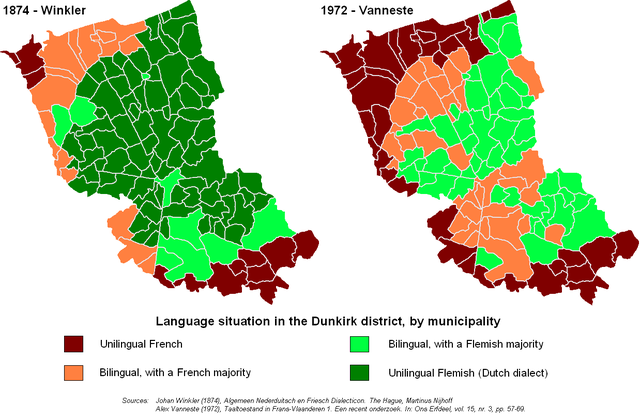Top Qs
Timeline
Chat
Perspective
French Flemish
West Flemish dialect of northern France From Wikipedia, the free encyclopedia
Remove ads
French Flemish (Fransch vlaemsch, Standard Dutch: Frans-Vlaams, French: flamand français) is a West Flemish dialect spoken in the north of contemporary France.
Place names indicate that Flemish was spoken as early as the 8th century in the region of Flanders that was ceded to France at the 1659 Treaty of the Pyrenees. This area became known as French Flanders. Its dialect subgroup, called French Flemish, meanwhile, became a minority dialect that survives mainly in Dunkirk (Duinkerke in Dutch, Duunkerke in West Flemish, "dune church"), Bourbourg (Broekburg in Dutch), Calais (Kales), Saint-Omer (Sint-Omaars), with its Flemish ethnic enclave of Haut-Pont (Haute-Ponte),[3] and Bailleul (Belle).
French Flemish has about 20,000 daily users, and twice that number of occasional speakers. The dialect's status appears to be moribund,[4] but there has been an active movement to retain French Flemish in the region.[1]
Remove ads
Status
Summarize
Perspective
Though generally seen as a dialect of Dutch, some of its speakers prefer to call it a regional language. Jean-Paul Couché, chairman of the Akademie voor Nuuze Vlaemsche Taele (ANVT), argues:[1]
Linguistically, a dialect depends on a larger, national language. That does not apply to French Flemish. We are not connected to standard Dutch because it is an artificial language that was created based on the dialects of North Holland. Research shows that the distance between French Flemish and Dutch is greater than that between Dutch and German.[1]
Although French Flemish and West Flemish are together with Limburgish the most distant dialects from Standard Dutch, Standard Dutch and Standard German are more distant still. However, that is not the case for dialects spoken at both sides of the Dutch-German border. This is partly due to the fact that those German dialects are not dialects of High German but of Low German and Low Franconian.


Remove ads
Education

A growing, re-introduced language, French Flemish is taught in several schools in the French Westhoek. The ANVT-ILRF was given permission to carry out experimental lessons in four public schools (in Esquelbecq, Noordpeene, Volckerinckhove, Wormhout) for the school years of 2007–08 until 2010–11, after which it would be evaluated. Afterwards, all requirements were met but it was only allowed to continue them, but not to expand to other schools or to the collège. On the other hand, the private Catholic education began teaching standard Dutch in collèges in Gravelines and Hondschoote.[5]
Remove ads
See also
Footnotes
External links
Wikiwand - on
Seamless Wikipedia browsing. On steroids.
Remove ads